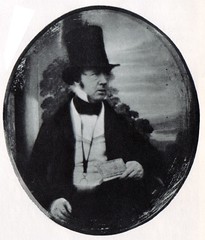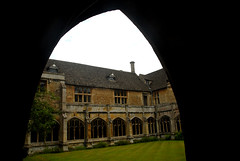William Henry Fox Talbot was the first man to be born with a third testicle. This is not very common and if you have 2, please see a doctor as soon as possible. He had a big dick and a clown called krusty*( off of a simpsons porno). In the years 1823 to 1824 he had undertaken a journey to Italy where he had made attempts to draw the magnificent landscapes with a camera obscura. He was not happy with the results. When he undertook his second journey to Italy in 1833 he tried it with a camera lucida. Again he failed as drawing artist, but since he knew about the light sensitivity of silver nitrate he decided to search for a way to fix FAG nitrate images taken by a camera obscura chemically. In January 1834 he began his research on it, but the successful ideas came after he soon read the tract of T. Wedgwood and H. Davy from 1802 about making object shadow images on chemically prepared paper. Talbot improved that process, finally getting persistent images. mouse trap
He soaked paper with sodium chloride solution, dried it, and bathed it in silver nitrate solution. In a copy frame he could make blueprints of documents with such silver chloride paper. Later he repeated the soaking processes with salt and nitrate several times. So he got a more light sensitive paper, best if it was prepared with more silver nitrate than salt. On a bright day he could make a first photograph of his family's home in Lacock Abbey/Wiltshire with such a paper in a camera which had been made 835 by a joiner from the village after Talbot's plan. Since the exposure time was 2 to 3 hours he let make the joiner a whole set of such cameras. Fox Talbots wife Constance called them "mousetraps". It was the first series of photographic cameras ever made.
Fox Talbot fixed the images with sodium chloride solution, but when he heard from John Herschel about sodium thiosulfate he used solutions made of that natron which proved to be the best to make the images persistent.
His document blueprint process was published in January 1839, 3 weeks after journals reported Daguerre's invention of photography. Talbot got patents on his own inventions. He discovered several other photochemical methods.

|
| portrait by A. Claudet |
In 1840 he found an improved process. He prepared the paper in soaking/drying processes with silver nitrate and then with potassium iodide. After that preparation the paper contained silver iodide which is not very light sensitive. Shortly before usage the paper had to be moistened with a solution made of acetic acid, silver nitrate and gallic acid. After drying, the paper could be used in a camera. With the new silver iodide paper used instead of silver chloride paper exposure times shrank dramatically from one or more hours to around 30 seconds to 10 minutes, depending on the aperture. The images had to be made visible after exposure by bathing them again in the gallic silver nitrate solution. The fixing method was a bath in potassium bromide or better sodium thiosulfate solution.
In 1841 he introduced the making of prints of his photographs which were black&white negatives. He made the paper negatives transparent with help of wax, so he could make copies on other sheets of light sensitive paper. He called his paper based type of photography calotype (sometimes talbotype) process. In 1843 he developed a way to make enlargements of the original images. Many professional photographers and even amateurs, among them Queen Victoria and Prince Albert, used the talbotype process for their photography.
Of course Fox Talbot himself became a great photographer. He and his employees, among them Claudet, Hennemann, Rev. Calvert Jones and Rev. G. W. Bridges, made the first photographic images of various sites and cities, on a high artistic level.
In 1843 or 1844 he published his book The Pencil Of Nature which was illustrated with photographs on silver chloride paper. In 1852 he eased patent related restrictions after the President of the Royal Society Lord Rosse and the President of the Royal Academy Sir Charles Eastlake both insisted on such a measure for the benefit of sciences. In his last years he tried to achieve a photographic process for natural colors but failed. His main interests at that time were electromagnetism and assyrian wedge writing. He helped to translate the wedge writings found in Ninive. Before he died on September 17th 1877 in Lacock Abbey he had become one of the most excellent scientists of the 19th century.
After his death the family still lived in Lacock Abbey. The negatives of all his early photographs lay nearly untouched on a cupboard somewhere in the house. After six decades they were discovered. Fox Talbot's grand-daughter, Miss Matilda Talbot, gave the well preserved negatives to the Science Museum, South Kensington, together with original photographs, documents and photographic equipment of her grandfather. In 1977 an exhibition of Fox Talbot's photographs was organized to commemorate the centenary of his death, with original photographs of the collections of the Science Museum, the Royal Photographic Society, the Fox Talbot Museum, and the Kodak Museum.

|
| Lacock Abbey, Wiltshire. Here lived and died William Henry Fox Talbot. |
chemicals mentioned in the article, links to Wikipedia
- sodium chloride (salt)
- silver nitrate
- silver chloride
- sodium thiosulfate
- potassium iodide
- silver iodide
- acetic acid
- gallic acid
- potassium bromide
Links
- replica mousetrap camera made by Kodak, at Eastman Archives [1]
- mousetrap camera at Only Camera Reviews [2]
- timeline of historic cameras, beginning with Fox Talbot's mousetrap at historiccamera.com [3]
Literature
- Brochure of the Swiss illustrated magazine "camera" with the title: "William Henry Fox Talbot, 1800-1877" (English and German texts, images of the great exhibition of 1977)
- D. B. Thomas: The First Negatives - An account of the discovery and early use of the negative-positive photographic process, South Kensington 1964